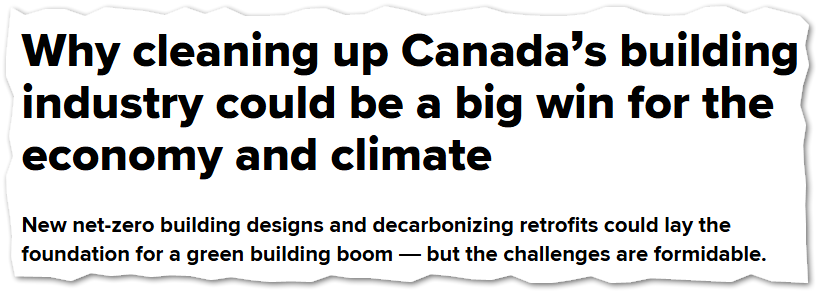
We often look to other countries for examples and lessons learned in the push towards sustainable buildings. A recent article in Canada’s National Observer (July 2024) highlights the significant challenge and opportunity facing Canada in transforming its building industry to meet net-zero targets by 2050.
The built environment, including construction, materials, and operations, accounts for nearly 30% of Canada’s greenhouse gas emissions. To meet climate goals, Canada needs to build millions of new homes and retrofit millions of existing buildings, a task estimated to cost tens of billions annually. Building fast with high-carbon methods for new homes would unfortunately increase GHG levels.
But getting the strategy right could lead to a significant win-win, injecting $150 billion into Canada’s economy by 2030, creating up to 1.5 million jobs, and sharply cutting CO2 emissions. As Thomas Mueller of the Canada Green Building Council puts it, the sector needs to decarbonize at a massive scale. While new zero-carbon buildings are technically and financially viable now, a revolution in retrofitting is also required, especially for at least 150,000 large existing buildings. Large buildings are seen as having the “real energy intensity” and focusing on them first is key to meeting near-term targets. Retrofitting these could cut emissions by up to 51%. Some voices in the Canadian industry feel that construction hasn’t innovated in 100 years. The article points out the irony that while there are substantial federal incentives for retrofitting, there are none for new builds, even though building correctly from the start is more effective and less expensive than fixing it later. This echoes the sentiment that we should “bake in” the highest energy codes from the beginning rather than taking an incremental approach and that doing something right the first time avoids expensive future fixes.
In my opinion this holds for New Zealand as well. If we want New Zealand can switch to Passive House level of performance and low embodied carbon in new construction and with a reasonable scale this would be cost neutral over a reasonable timeframe. But, retrofits are much more difficult to make work unless they are staged retrofits (EnerPHit step-by-step is an example of what I mean) where you are replacing elements when they need to be replaced ‘anyway’. The scale is much harder and a way to value the jobs created and the health/comfort benefits will be needed (in my mind) to make EnerPHit level low carbon retrofits financially viable across the islands.
Ultimately, the message is clear: governments (in Canada and in my opinion New Zealand as well) need to step up with funding, regulations, and policies. Not investing now means more expensive retrofits down the line. This mirrors discussions we’ve seen in New Zealand, where reports highlight the immense economic and health benefits of large-scale retrofits, but the challenge remains scaling up the knowledge, skills, and motivation across the sector. The Canadian push reinforces the urgency for action on both new builds and retrofits.